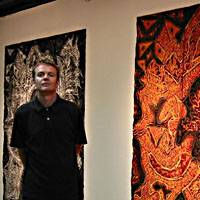"To be an honest artist, you have to be concerned with living life to the fullest," said Wayne Crothers.
An Australian from Melbourne, Wayne, a woodblock print artist, is exhibiting for his third time in this autumn's College Women's Association of Japan Print Show. He says his work typically includes many abstract elements always within recognizable forms. "I want to produce art which is beautiful, but which also has deeper meanings to provoke thought on social and international issues," he said. "I try to convey ideas to encourage people to appreciate nature and to be interested in things beyond their daily lives, to view the world on a grander scale."
Wayne, now 42, began working out his attitude to life and his personal aspirations from as long ago as his high-school years. He chose to take a diploma course in art and design at Victoria College, Melbourne. "I was interested in doing my own work, in expressing my own feelings in a visual manner," he said. "I was very optimistic. Art enables me to have optimism, to find an outlet for my feelings. To be without outlet for concepts is frustrating, and pessimism can set in. The challenge of life is to remain optimistic."
True to his credo, Wayne set out after art school to experience the world. He packed the following years with travel to India, Pakistan, China, the Middle East and Japan. He received ideas and inspiration, pursued his independent research and produced his own art. He said: "I was very interested in Japanese cultural elements, the aesthetic and historical aspects. I wanted to come back to Japan to research woodblock printing here."
He remembers that his father used to work in a professional printing shop. "When I was in primary school, my father used to let me work for some summer pocket money in his screen printing studio. Maybe that laid a base for my interest in print and art. I do see a strong connection between then and now."
Before returning to Japan he did some preliminary work, "following European forms, doing some elementary woodcuts in German black-and-white style." After enrolling in Kyoto Seika University, he realized his intention "to use traditional woodblock techniques with a modern outlook." He went on to earn a master's degree at Tama Arts University, Tokyo.
Over the last few years, Wayne has moved around in teaching and artist-in-residence positions from Japan to Australia, from the Joan Miro Foundation in Spain to Lafayette College, Pa., to the Gyor City Art Museum, Hungary. He has given individual exhibitions in countries as widely separate as those in which he lived, and participated in group exhibitions in at least a dozen other countries. He has received awards. His work is in important collections and is reviewed in reputable publications around the world.
At one stage while living and working in Sapporo, Wayne said he became "a little bit settled there. I made my own studio. I enjoyed the Hokkaido outdoor lifestyle. But it was lonely, so I decided to come back to Tokyo and have some time with students again." He is currently a lecturer at Musashino Art University, Tokyo.
As he continues to move around questing and producing, Wayne keeps his connections with Australia "artistically in Canberra and Sydney, personally in Mel- bourne." His future, he says, is as much a mystery as anyone's, though his aims are clear-cut. "I hope to have the energy to produce more, and to pursue my ideas and concepts. So many interesting things go on socially and internationally. My duty is to use those aspects to create my work," he said.
He has two prints on show and for sale at the upcoming print show. This will be the 49th annual CWAJ Print Show, which many regard as a premier showcase for contemporary Japanese print art. This year, 217 prints produced by 165 artists will be included. The show is open each daytime from Oct. 15 to 17 at the Tokyo American Club. A smaller associate show on the same days focuses on possibilities in the use of nontraditional media in printmaking. Some prints are to be shown in advance of the main show at an evening lecture on Oct. 6 at the club. Sale proceeds will go to CWAJ's fund for scholarships for Japanese women studying abroad, non-Japanese graduate women studying in Japan, and visually impaired people.

















With your current subscription plan you can comment on stories. However, before writing your first comment, please create a display name in the Profile section of your subscriber account page.